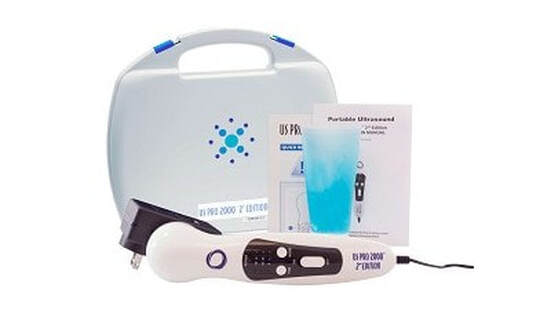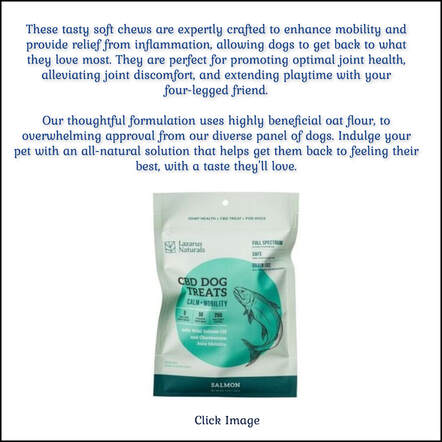What is ultrasound therapy?
|
|
By Animal Acupuncture
Ultrasound is a physical therapy treatment for tendon and ligament injuries. It allows tendon injuries to heal more rapidly, and it promotes collagen fiber formation to maximize the long-term strength of the tendon. It also helps control the pain associated with arthritic joints. Why use ultrasound therapy to treat dogs? Veterinary doctors are now using many of the same physical therapies successfully used to treat humans. Health experts have employed ultrasound as a healing modality for humans for over sixty years. Veterinarians began using ultrasound to treat dogs about twenty years ago. Extensive research confirms its benefits. How does ultrasound work? Ultrasound therapy uses an ultrasound probe to send high-energy sound waves into desired tissues. As the tissues absorb the waves, they are converted to heat. In that sense, ultrasound therapy works very similarly to heat therapy. |
Which conditions are normally treated with ultrasound?
Some of the most common conditions include:
Some of the most common conditions include:
- Tendon and ligament injuries
- Muscular back pain
- Wound healing and reduction of scar tissue
- Pain and muscle spasms
- Reduction of swelling
|
What are the benefits of ultrasound therapy?
Ultrasound effectively treats joint conditions and soft tissue injuries by decreasing swelling, promoting the healing of sores and surgical wounds, and reducing scar tissue around joints. Thus, joints can work more effectively, employing full range of motion. It also improves circulation, thereby increasing the pliability of muscles, ligaments and tendons. How do I know if my dog will benefit from ultrasound therapy? A veterinary evaluation is necessary to determine the involved tissue and stage of tissue healing before treatment begins. Since the effects depend on the power and frequency applied, ultrasound application requires skilled practitioners. Why use ultrasound therapy in place of drug treatment? Most dogs benefit from drug free alternatives. These treatments relax them and make them feel good, and, in turn, enhance their performance with fewer injuries. |
US Pro 2000 2nd Edition Portable Ultrasound Therapy Device [+ FREE 8oz Conductive Gel]
This is for pain and inflammation and penetrates the soft tissues for faster healing and recovery. Please speak with your physical therapist or veterinarian on using this with your dog. Do not use on the face or thin parts of the skin with little or no muscle.
The US Pro 2000® 2nd Edition is a clinical grade therapeutic ultrasound device that helps with effective pain relief. The pulsed sound waves travel deep into the tissue and induce vasodilation, which helps increase blood flow to the treated area and is found to help relieve pain and reduce muscle spasms. It comes uniquely equipped with a soundhead pre-warming feature on an ergonomically designed sound head for increased patient comfort. Before starting therapy the soundhead preheats so that it's more comfortable and warm. Once therapy is engaged, the pre-warming feature turns off to allow for the most effective treatment.
With three output intensities, and three treatment time selections, the US Pro 2000® 2nd Edition can provide a wide range of therapy treatments. The aluminum sound head is watertight for use in underwater therapy (for 30 minutes), though only the metal portion is watertight - you can not submerge the entire sound head.
This new and improved portable therapeutic ultrasound unit is a great choice for non-invasive pain relief. No more pain meds or pills, this unit is very similar to the one used in your Chiropractor's or Physical Therapist's office.
They also make a Pro 1000 and is less in strength. Please go to their website to learn more.
The US Pro 2000® 2nd Edition is a clinical grade therapeutic ultrasound device that helps with effective pain relief. The pulsed sound waves travel deep into the tissue and induce vasodilation, which helps increase blood flow to the treated area and is found to help relieve pain and reduce muscle spasms. It comes uniquely equipped with a soundhead pre-warming feature on an ergonomically designed sound head for increased patient comfort. Before starting therapy the soundhead preheats so that it's more comfortable and warm. Once therapy is engaged, the pre-warming feature turns off to allow for the most effective treatment.
With three output intensities, and three treatment time selections, the US Pro 2000® 2nd Edition can provide a wide range of therapy treatments. The aluminum sound head is watertight for use in underwater therapy (for 30 minutes), though only the metal portion is watertight - you can not submerge the entire sound head.
This new and improved portable therapeutic ultrasound unit is a great choice for non-invasive pain relief. No more pain meds or pills, this unit is very similar to the one used in your Chiropractor's or Physical Therapist's office.
They also make a Pro 1000 and is less in strength. Please go to their website to learn more.
What is Therapeutic Ultrasound?
By Wagwalking
Therapeutic ultrasound is a physiotherapy technique that aims to speed up the healing of damaged muscles, tendons, or ligaments by reducing inflammation and the amount of scar tissue laid down.
Therapeutic ultrasound is a very high frequency sound wave that when applied to tissue via a probe head, causes the molecules in its path to vibrate at a microscopic level. This has various beneficial effects including increasing the blood circulation to the area (which brings in healing cells and helps disperse natural toxins), decreases swelling, and speeds the rate of healing.
Therapeutic ultrasound requires repeated visits, but the patient does not usually need sedation for this therapy.
Therapeutic Ultrasound Procedure in Dogs
Therapeutic ultrasound is not painful and in most calm animals can be undertaken without the need for sedation, indeed many patients find the therapy pleasantly warming. However, there does need to be good contact between the head of the ultrasound probe and the skin, which means that in most cases fur needs to be clipped away.
The clinician applies a water-based ultrasound gel over the area, which improves the conduction of the ultrasound waves into the deeper tissues. The probe is applied for 10 - 20 minutes at a time, usually with the probe moving in gentle stroking sweeps or a small circular movements over the affected area.
The therapy is repeated two to three times a week, until the desired improvement in the movement of the joint or muscle is achieved. Therapeutic ultrasound should only be undertaken under the direction of a veterinarian, thus referral from the vet to the physiotherapist is necessary.
Therapeutic ultrasound is a physiotherapy technique that aims to speed up the healing of damaged muscles, tendons, or ligaments by reducing inflammation and the amount of scar tissue laid down.
Therapeutic ultrasound is a very high frequency sound wave that when applied to tissue via a probe head, causes the molecules in its path to vibrate at a microscopic level. This has various beneficial effects including increasing the blood circulation to the area (which brings in healing cells and helps disperse natural toxins), decreases swelling, and speeds the rate of healing.
Therapeutic ultrasound requires repeated visits, but the patient does not usually need sedation for this therapy.
Therapeutic Ultrasound Procedure in Dogs
Therapeutic ultrasound is not painful and in most calm animals can be undertaken without the need for sedation, indeed many patients find the therapy pleasantly warming. However, there does need to be good contact between the head of the ultrasound probe and the skin, which means that in most cases fur needs to be clipped away.
The clinician applies a water-based ultrasound gel over the area, which improves the conduction of the ultrasound waves into the deeper tissues. The probe is applied for 10 - 20 minutes at a time, usually with the probe moving in gentle stroking sweeps or a small circular movements over the affected area.
The therapy is repeated two to three times a week, until the desired improvement in the movement of the joint or muscle is achieved. Therapeutic ultrasound should only be undertaken under the direction of a veterinarian, thus referral from the vet to the physiotherapist is necessary.
Efficacy of Therapeutic Ultrasound in Dogs
Used in the human field for rehabilitation as well as the treatment of sports injuries, therapeutic ultrasound is a respected physiotherapy method. It has the major advantages of being drug-free and comfortable enough to use without sedation. Whilst it will not produce miracles, when used correctly it is unlikely to worsen a condition and highly likely to benefit it.
It is important only take the advice of a vet, as to whether therapeutic ultrasound is appropriate for your dog or not. There are some contraindications where the effects of this type of ultrasound are either not known or there is a chance of complications. The conditions for which it is not advised include:
Pregnancy: The effects of prolonged exposure to therapeutic ultrasound during pregnancy are not known, therefore any risk is best avoided
Cancer: The increased blood supply to an area could encourage the spread of cancer cells to other parts of the body.
Metal Orthopedic Implants: The pins, plates, or screws used to repair a fractured bone may heat up under prolonged exposure to therapeutic ultrasound. This will cause discomfort and pain, and is undesirable.
Used in the human field for rehabilitation as well as the treatment of sports injuries, therapeutic ultrasound is a respected physiotherapy method. It has the major advantages of being drug-free and comfortable enough to use without sedation. Whilst it will not produce miracles, when used correctly it is unlikely to worsen a condition and highly likely to benefit it.
It is important only take the advice of a vet, as to whether therapeutic ultrasound is appropriate for your dog or not. There are some contraindications where the effects of this type of ultrasound are either not known or there is a chance of complications. The conditions for which it is not advised include:
Pregnancy: The effects of prolonged exposure to therapeutic ultrasound during pregnancy are not known, therefore any risk is best avoided
Cancer: The increased blood supply to an area could encourage the spread of cancer cells to other parts of the body.
Metal Orthopedic Implants: The pins, plates, or screws used to repair a fractured bone may heat up under prolonged exposure to therapeutic ultrasound. This will cause discomfort and pain, and is undesirable.
Therapeutic Ultrasound Recovery in Dogs
A dog that needs therapeutic ultrasound will likely be under the care of a vet or veterinary physiotherapist. Whilst the treatment itself has minimum short-term impact on the patient, it's likely they will need to adhere to a specific exercise or physiotherapy regime as part of the recuperation process.
How swiftly the patient sees a benefit depends largely on the nature of a problem. For example, clinicians passing a therapeutic ultrasound probe over the incision from a routine ovariohysterectomy find even a single treatment speeds up wound healing. Whereas a joint that has seized up as a result of an old injury may could take multiple weeks of therapy to show a satisfactory improvement.
Cost of Therapeutic Ultrasound in Dogs
You may need an initial assessment by a veterinary physiotherapist. Costs vary, but around $66 to $125 for a 60-minute assessment is common. Subsequent sessions cost $35 to $100 each, depending on the type of equipment used and the experience of the operator.
Remember, this cost is per session, so for a dog that needs three treatments a week for a couple of months this can amount to a sizeable cost.
A dog that needs therapeutic ultrasound will likely be under the care of a vet or veterinary physiotherapist. Whilst the treatment itself has minimum short-term impact on the patient, it's likely they will need to adhere to a specific exercise or physiotherapy regime as part of the recuperation process.
How swiftly the patient sees a benefit depends largely on the nature of a problem. For example, clinicians passing a therapeutic ultrasound probe over the incision from a routine ovariohysterectomy find even a single treatment speeds up wound healing. Whereas a joint that has seized up as a result of an old injury may could take multiple weeks of therapy to show a satisfactory improvement.
Cost of Therapeutic Ultrasound in Dogs
You may need an initial assessment by a veterinary physiotherapist. Costs vary, but around $66 to $125 for a 60-minute assessment is common. Subsequent sessions cost $35 to $100 each, depending on the type of equipment used and the experience of the operator.
Remember, this cost is per session, so for a dog that needs three treatments a week for a couple of months this can amount to a sizeable cost.
Dog Therapeutic Ultrasound Considerations
Therapeutic ultrasound is about encouraging a natural process - repair - to proceed in an orderly way so that inflammation, pain, and scar tissue are kept to a minimum. When the correct patients are selected (ie those that don't have cancer or metal implants) then there is very little risk attached to the therapy.
However, it should be noted the therapeutic ultrasound will most benefit the patient when used as part of a protocol that may also include therapeutic massage, hydrotherapy, or rehabilitation exercises. This takes considerable dedication on the part of the owner, if the dog is to derive maximum benefit.
Therapeutic Ultrasound Prevention in Dogs
Avoiding the need for therapeutic ultrasound hinges on healthy joints and warming the dog up before vigorous exercise to reduce the risks of sprains and strains. Creating healthy joints starts even before you acquire the puppy, by doing research into responsible breeders and sourcing a puppy that is from parents screened and passed as clear for conditions such as hip dysplasia.
In addition, for large breed dogs they should be fed as puppies on a large breed growth diet. This reduces the risk of the dog's bones growing too quickly, which predisposes them to damaged cartilage or weak joints.
Other sensible precautions include not over-exerting the dog during exercise, until they are finished growing. To this end, dogs should not attend agility classes until they are 12 to 18 months old (depending on size and breed).
When a dog is lame, seek prompt veterinary treatment. Using anti-inflammatory drugs at an early stage can reduce inflammation of the delicate cartilage lining the joints and protect it from being chipped or torn. In addition, for breeds that are prone to joint problems, starting a nutraceutical product containing chondroitin and glucosamine could be a beneficial investment in long term joint health.
Therapeutic ultrasound is about encouraging a natural process - repair - to proceed in an orderly way so that inflammation, pain, and scar tissue are kept to a minimum. When the correct patients are selected (ie those that don't have cancer or metal implants) then there is very little risk attached to the therapy.
However, it should be noted the therapeutic ultrasound will most benefit the patient when used as part of a protocol that may also include therapeutic massage, hydrotherapy, or rehabilitation exercises. This takes considerable dedication on the part of the owner, if the dog is to derive maximum benefit.
Therapeutic Ultrasound Prevention in Dogs
Avoiding the need for therapeutic ultrasound hinges on healthy joints and warming the dog up before vigorous exercise to reduce the risks of sprains and strains. Creating healthy joints starts even before you acquire the puppy, by doing research into responsible breeders and sourcing a puppy that is from parents screened and passed as clear for conditions such as hip dysplasia.
In addition, for large breed dogs they should be fed as puppies on a large breed growth diet. This reduces the risk of the dog's bones growing too quickly, which predisposes them to damaged cartilage or weak joints.
Other sensible precautions include not over-exerting the dog during exercise, until they are finished growing. To this end, dogs should not attend agility classes until they are 12 to 18 months old (depending on size and breed).
When a dog is lame, seek prompt veterinary treatment. Using anti-inflammatory drugs at an early stage can reduce inflammation of the delicate cartilage lining the joints and protect it from being chipped or torn. In addition, for breeds that are prone to joint problems, starting a nutraceutical product containing chondroitin and glucosamine could be a beneficial investment in long term joint health.
**Canine Arthritis And Joint is intended for informational, educational and entertainment purposes only and is not a substitute for medical advice, diagnosis or treatment. Do not attempt to self-diagnose or treat any health condition. You should always consult with a healthcare professional before starting any diet, exercise or supplementation program, before taking any medication, or if you have or suspect your pet might have a health problem. The opinions expressed by Canine Arthritis And Joint are not to be replaced for medical care. This website and the information contained herein have not been evaluated by the Food and Drug Administration. The information and opinions on Canine Arthritis And Joint are not intended and cannot be used to diagnose, treat, cure, or prevent any disease. This applies to people and pets!
This site uses affiliate links such as banners you may see that allows for paid commissions.
This site uses affiliate links such as banners you may see that allows for paid commissions.
Canine Arthritis And Joint © Copyright 2015-2024
Designed By Paw Prints Web Design
Designed By Paw Prints Web Design













